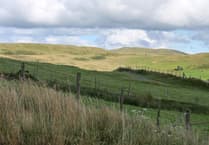Four ‘unviable’ village primary schools look set to be closed from next year after Ceredigion County Council cabinet members voted to launch consultations on shutting the doors of the quartet in August next year despite local protests.
Pupils now face only having just one more year in their current schools of Ysgol Craig yr Wylfa in Borth, Ysgol Llanfihangel y Creuddyn, Ysgol Llangwyryfon, and Ysgol Syr John Rhys in Ponterwyd before continuing their education elsewhere.
Protestors from each of the four schools rallied outside Ceredigion County Council’s Penmorfa headquarters in Aberaeron on Tuesday, 3 September ahead of a Cabinet meeting and packed the council chamber while members decided the future of the schools.
Protests outside Ceredigion council's Penmorfa offices in Aberaeron
The meeting became fiery at several points, with councillors and Cabinet members clashing over the closure plans, while an outburst from prominent Welsh language campaigner Ffred Ffrancis as discussions went on caused the meeting to be paused, and children brought to the meeting with parents began running around the council chamber bored as discussions dragged on - reaching more than seven hours of heated discussions before all decisions were made.
The marathon discussions on the closures, which stretched to beyond 6pm from a 10am start, meant that decisions on key budget savings on the original agenda including the closure of Tregerddan Care Home in Bow Street and charging for parking on Aberystwyth promenade had to be delayed.
The meeting heard from council leader Cllr Bryan Davies that it was a “challenging” day and that “difficult decisions” had to be made.
He told members that if more people supported their local schools by sending their children there “we wouldn’t be having these discussions today.”
Cllr Wyn Thomas, the Cabinet member for education, told members that “unfortunately the overall reduction in pupil numbers is causing problems, particularly in our rural schools.”
“We are trying to face the challenges that are happening,” he said.
“These schools won’t be able to maintain staff [under the current budgets].
“The reports show that it is not appropriate to continue education in these schools because they are not viable.”
Members heard that while closing the schools would cause “instability” for pupils, some staff losses, and increased costs, “sustainability” of schools was a “paramount consideration.”
While objectors to the closure of several of the schools questioned the accuracy and validity of the financial figures and other details in the reports, the meeting were “assured” by Chief Executive Eifion Evans that the figures were accurate.
Accusations from Borth Cllr Hugh Hughes, reported by the Cambrian News last week, that there were “widespread procedural failures” in the drawing up the closure plans, and that officers had “not acted openly, transparently or without bias” were also dismissed by Mr Evans who said that officers “would not lie.”
Allegations were also mentioned that officers had included misleading information in their reports on the schools, with leader Cllr Davies telling members “quite serious allegations have been presented.
“The allegation is officers have lied; the decision is difficult to make for us as a Cabinet, if the allegation that what is put in the papers is not correct; we must know what is put in the papers is correct,” he said.
The allegations were refuted by chief executive Eifion Evans, who said: “If any officer makes lies there would be a process to follow ; it’s the duty of the officers to be entirely factual, if there is proof of that I want to see it on my desk.

“Nobody has brought any information to my attention.
“If there is any evidence that someone lied then that will be investigated.
Cllr Hughes told the meeting he was “disappointed” with the reports as “we’re looking at pounds and pennies instead of the effect on communities.”
The meeting also heard that a “number of complaints” have been received by the council over the process of the proposed closures.
Local residents in the affected villages have questioned projected pupil numbers for each school, with data pulled from the Welsh Government instead of incorporating local data where a few extra children at each school would affect the outlook.
Eifion Evans said the pupil number data used in the reports was the one required by law but that “local data” would from a part of the consultations.
The meeting was also told the Welsh Government's School Organisation Code was followed when drawing up the proposals, despite complaints from Welsh language campaigners Cymdeithas yr Iaith.
The group wrote to the council to warn the basis of proposals to consult on the closure of the four schools is “incorrect” because “several options that were not considered in the proposal papers.”
The meeting heard however, that officers followed the code in drawing up the plans.
The proposals are the first to be drawn up under the new code, which calls for the presumption of keeping rural schools open.
Cllr Gareth Davies told members: “If the code calls for the presumption of keeping rural schools open then it should have a separate funding formula for schools with 30 pupils so we can keep them open.
“The last thing I want to do is close schools but at the end of the day we only have a finite amount of funding available.”
The meeting heard that while the papers say that closure of the four schools is the only option to meet the savings target, the closures were “not a done deal” ahead of consultations.
“While we are saying that closure is the only option,” Eifion Evans told the meeting, “the consultation is an opportunity to look at other options.”
Cllr Gareth Lloyd said he hoped that consultation responses would be “listened to” before any final decisions are made.
Ffred Ffransis, of Cymdeithas yr Iaith’s Education Group interjected towards the end of the discussion on Ysgol Llanfihangel-y-Creuddyn, when cabinet members began suggesting alternate options for the fate of the school other than closure.
“By that point the discussion had become farcical, and extremely misleading, as the proposal papers have already set out closure as the predetermined outcome of the consultation, without any kind of open or democratic engagement with the communities these decisions will impact,” he said.
“The Welsh Government’s School Organisation Code clearly states that all other options apart from closure must be considered while proposals are still at a formative stage, with a presumption in favour of maintaining rural schools.
“Nobody can seriously claim that due process has been carried out by Ceredigion Council, as the formative stage of the council’s policy has taken place behind closed doors.”
Cymdeithas Yr Iaith has said that following the votes to move to consultation they will submit a complaint to the Minister for Education.
Cllr Meirion Davies, whose ward represents Llanfihangel y Creuddyn, said it was “disappointing to close schools that are at the heart of their communities” and called for Cabinet members to chuck out the proposals.
“Moving children and closing the school takes the heart out of the community,” he said.
.png?trim=0,2,0,1&width=752&height=501&crop=752:501)
Cllr Shelley Childs told members: “These villages are losing their pubs, losing their shops, if they lose their schools there won’t be much left.”
Cllr Gwyn Wigley Evans said that cost figures in the report for Ysgol Llangwyryfon in his ward were “incorrect” and that pupil numbers are likely to increase at the school, despite what the report suggests.
“They have been skewed to show the position is worse than it is,” he said.
“They are so many flaws here.”
Cllr Wyn Evans told members: “I’m going to leave here with a heavy heart today.
“I’d like to congratulate the people of Llangwyrfyon for fighting for their school.”
Cllr Rhodri Davies, who has Ysgol Sir John Rhys in his ward, said it was “important to keep schools as part of the community” and urged for the school to be kept open.
As with all the cuts that the Plaid Cymru administration in Ceredigion have pushed through, Cabinet members heard that the closures are necessary because the funding formula received by Welsh Government was “entirely insufficient” to maintain services.
Cllr Alun Williams said that the council has received “devastating cuts” from Welsh Government, so it’s “not a surprise” that cuts in education – which makes up a third of the council’s budget – will have to be made.
Eifion Evans told members: “It’s not a question of the standard of education in these schools – they are excellent – it is simply a question of funding.
“We are not the enemies, we are not the enemies of each other [in this chamber], the enemy here is the funding formula for rural Wales.”
Mr Evans warned that if the schools were allowed to stay open it would be extremely difficult for them to set a balanced budget as required by law.
“We cannot continue to support the vulnerable people in our county and support our education service [within the current budget],” he said.
The meeting heard that the closures were being earmarked despite a 3.1 per cent boost for the education services budget from the 11.9 per cent council tax increase for residents from April.
Members, deciding to approve plans to launch consultations on the closures, heard that Ceredigion County Council argues that the low pupil numbers and surplus places at the four schools do not fit with its latest plan for school re-organisation, approved by Cabinet in May last year.
While the average cost per pupil in Ceredigion is £4,635, in Craig Yr Wylfa – where there are 30 pupils with 44 surplus places – the cost per pupil is £7,640.
Pupil numbers at the Borth school have declined from a 42 in 2020, with a projection of just 22 pupils by 2029.
In Llanfihangel y Creuddyn, the school has a capacity of 37, but has 20 pupils currently enrolled.
Pupil numbers have fallen every year since 2020 and now has a cost per pupil of £6,978.
In Llangwyryfon, the school has 30 current pupils against a 55 pupil capacity, with a cost per pupil of £6,321.
Ysgol Sir John Rhys is a little over half full, with 21 pupils on the roll with capacity for 39.
It is the most expensive per pupil primary school in Ceredigion with a current cost of £7,949.
Under the preferred council plan, all four schools would shut their doors in 2025 with pupils at Craig Yr Wylfa moved to Ysgol Talybont, and youngsters from Ysgol Llanfihangel y Creuddyn and Ysgol Llangwyryfon transferred to Ysgol Llanilar.
Ysgol John Rhys pupils would be transferred to Ysgol Mynach, although the meeting heard that Ysgol Penllwyn in Capel Bangor may also be an option during consultation discussions.
Free transport for pupils will only be provided to the designated schools identified by the council, the meeting heard, and if parents move their children to a different school, no free transport will be provided.
Any plan to form partnerships or federations between schools in a bid to keep schools open “would not lead to the required financial savings” nor solve the problem of declining pupil numbers, members heard.
If all four schools close, the report outlines, the county council would save around £200,000 a year, despite additional transport costs for displaced pupils estimated at more than £1,000 a day.
The projected financial savings from the closures do not include any cash generated from any potential sales of the closed school sites.
The closures of the schools would leave Ceredigion with just 32 primary schools, down from 70 at the turn of the century.
Another three unnamed schools were also earmarked for potential closure, but the meeting heard a decision was made to move ahead with just the four on the chopping block at the moment.
The meeting heard from officers, however, that those also remained a possibility those closures would be revisited, with more small school closures in the near future not ruled out.
Statutory consultations on closing the four schools will now be launched.
Any final decision to close a school will be made by full council.





Comments
This article has no comments yet. Be the first to leave a comment.